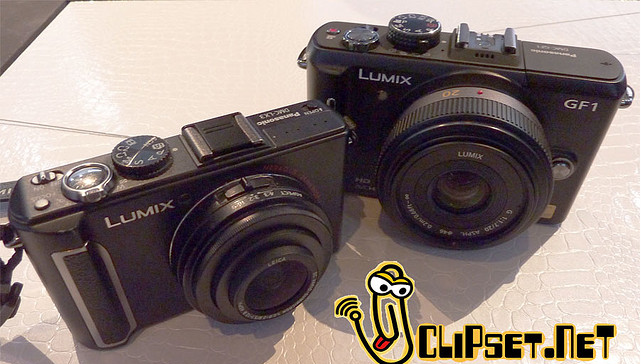(Note: this article is supposed to be a summary of the decision process and complexities for buying a new camera. But then I asked Herr J to "look it over" and, well, you see what happened... Apologies to anyone who does not have an engineering PhD or permanent pocket protector!)
There are some pretty interesting technological developments today in digital cameras: mirrorless interchangeable-lens designs (the Panasonic / Olympus micro four-thirds standard, and APS-C models from Sony and Samsung), translucent mirrors in DSLRs, and even Phase One's over the top 30 megapixel medium format imaging sensor... now being replaced by an 80 megapixel version! (For around $44,000 you could buy a car instead.)
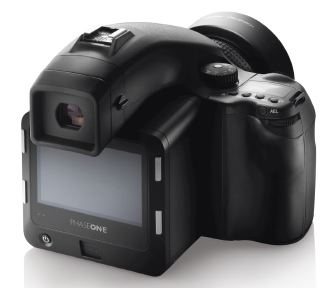
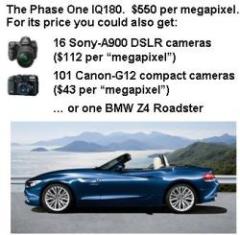
Alternative sensor techologies have been developed too, but are not making significant headway yet. Fuji has a "reconfigurable" sensor, and Foveon a multi-layer sensor. Ricoh went further out into left field, and has the GRX system which is a compact camera shell that uses interchangable units combining sensor and lens together! (pretty smart, out of the box thinking!)
Plus, there are increasingly good plain old point-and-shoot models. The new Olympus XZ-1 has the "fastest" lens ever on a compact digital camera (at 28mm is f1.8!) and the Canon SX30IS has the largest focal range of any fixed lens camera ever made (35x, from 24-840mm!). As always, there are a slew of proven APS-C and full-frame DSLRs that are the bread and butter of pros worldwide.
There are even innovations in accessories, such as a 3-D lens (for use on 3-D televisions!), wireless hot shoe attachments that send photos to any bluetooth device, and alien-looking lights for macro photography. But in the end it all boils down to your camera/system working in your lifestyle & budget.
I'm a Nikon person... I love, love, LOVE my D700. It can't be beat for it's color rendition and low-light capabilities. I'm not the only one -- one husband made a D700 birthday cake for his wife! And it's red velvet, too!!!
 http://www.kenrockwell.com and http://www.woohome.com/food-drink/a-wifes-birthday-cake-nikon-d700/1984
http://www.kenrockwell.com and http://www.woohome.com/food-drink/a-wifes-birthday-cake-nikon-d700/1984
I know many will call it heresy, but I also love my Panasonic LX3. Though the Nikon does fit in my larger purses even with a decently large lens, I just can't lug it around all the time. The LX3, however, is tiny (but built like a tank) and takes really great pictures, especially in low light. (In fact, the LX3 actually changed the market in this regard. All major players were forced to make a competing model in order to stay relevant: Canon S90/S95, Nikon P7000, Olympus XZ-1, and Panasonic's upgrade, the LX5). I also love my LX3 because of the awesome 10 Bar underwater housing that Herr J and my friends in TX gave me for my last birthday. Best Present Ever! It's a great set up for diving - I'd considered keeping my old D40 as an underwater camera, but the housings for those start around $2,000 and require different fronts for different lenses!!! The 10 Bar and LX3 combo is so great that I've recently bought another (slightly used) LX3 to replace it when the camera wears out. I started diving with a Sony Cybershot circa 2001, and sadly the camera stopped working long before the housing. We did have a good 10 years together, but it just won't hold more than 15 or 30 minutes of charge anymore.
Herr J is in the market for a new camera, though he's been "in the market" as long as I've known him! It's a pretty big step when investing in a camera system. Whereas I'm already committed to a lifetime of Nikon (except for fixed lens compact cameras), he's still able to make a radical choice and go with newer systems and standards. Is it better to invest in new models & lens mounts -- with the risk that they don't have longevity, or just stick with today's DSLRs?
Or perhaps one chooses a system based on available high-quality lenses and just gets a cheap body to start. For example, I have some "good glass" that will last decades and I can reuse on any future camera bodies that have the same Nikon interchangeable lens mount, e.g., if I ever have/want to replace my D700.
What about the portability factor, like with my LX3 vs D700 -- should Herr J get a compact AND a large sensor camera, or just one mirrorless in-between size? And what about the cost of getting an underwater housing for the camera as part of the total investment? Housings can cost more than the cameras themselves! (He loved our vacation photos with the LX3 + 10 Bar housing.)
We've had some good debates about the camera market, and enjoy playing around with different models in the local electronics store. The current hot topic is "who buys into the micro four-thirds system?" Ostensibly, micro four-thirds is "better quality than a compact, smaller than a DSLR". It's an interesting concept and I'm curious to know if it ends up being a long-term market segment or just a brief stop on the way to something new. Obviously it appeals to early adopters who want the latest technology... and those who want better image quality than fixed lens compact cameras. But that's the irony...once you put a lens on it, it's not truly "small" anymore.
Here's the Panasonic LX3 compared to Panasonic's smallest mirrorless interchangeable lens camera, the GF1. The GF1 has a "pancake" lens attached:
The GF1 is little taller and deeper (front to back) and might fit in large pockets -- very portable in any case. But the LX3 has a 3x zoom capability, whereas the GF1 "pancake" has no zoom -- and most people will miss this. Well... although the LX3 has a fixed lens, we can changes lenses on the GF1. So, let's put a lens on the GF1 that is equivalent to the 3x zoom on the LX3. In this case, we'll substitute Canon's G11-- a direct competitor of the LX3 and similar size (a bit bigger, actually). Here's what we get: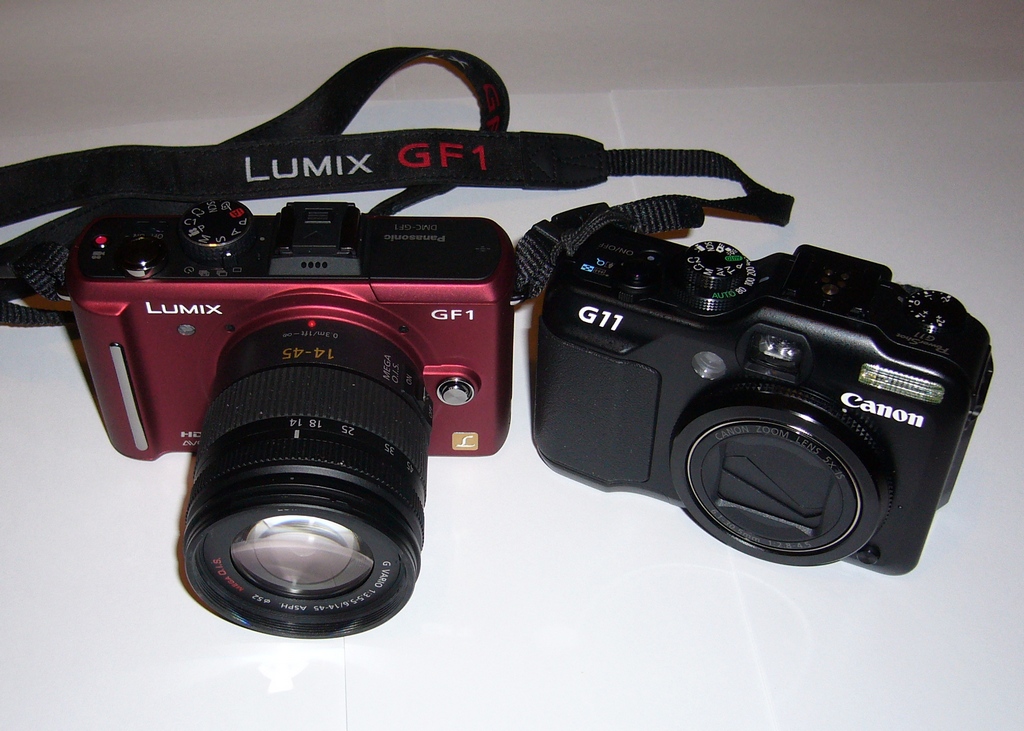
Whoa. We just added a good 2-3 inches to the depth of the camera with that lens. It's not fitting in anyone's pocket, but still fits in purses/bags. That's the price you pay for getting an improvement in image quality. The GF1's sensor is 6x larger than the sensor in the LX3 or G11 -- it needs a bigger lens to cover the sensor, but puts out better photos. Is this worth the decrease in portability? Hmm....
On the flip side, "m4/3" cameras are somewhat smaller & lighter than a typical DSLR because of the lack of mirror & prism, a smaller sensor & matching lenses. Here's the Olympus m4/3 camera vs. one of the smallest DSLRs on the market (also from Olympus).
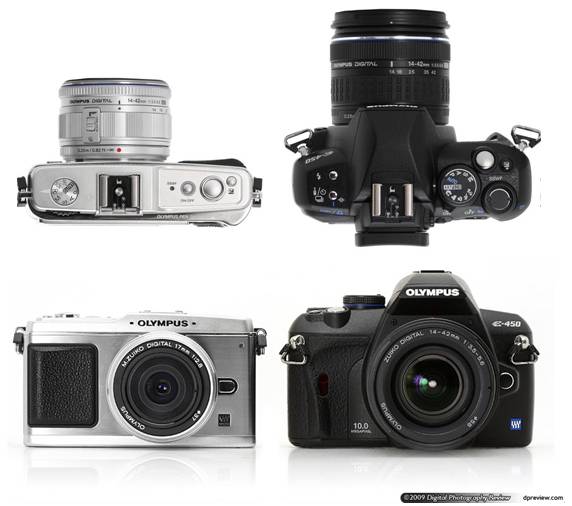
There is definitely a reduction in size -- both heigth and depth, plus weight. However, with the current market offerings, the small DSLR costs the same or less and delivers higher performance (faster shooting, less noise at high ISO, and greater dynamic range. Plus the DSLR has a viewfinder and much better external controls for those that manual control of the camera (rather than leaving it in Automatic mode) We definitely lose performance with the m4/3, but did the reduction in size really give us more portability? Remember, neither camera will fit in a pocket, so we have to transport it differently. So where's the right place on the size/quality/price curve?
Lots to think about here. But maybe it won't be decided on technical metrit.
I pointed out these issues to Herr J, but he laughed and then said, "But most importantly, will it fit in my man purse better?"
